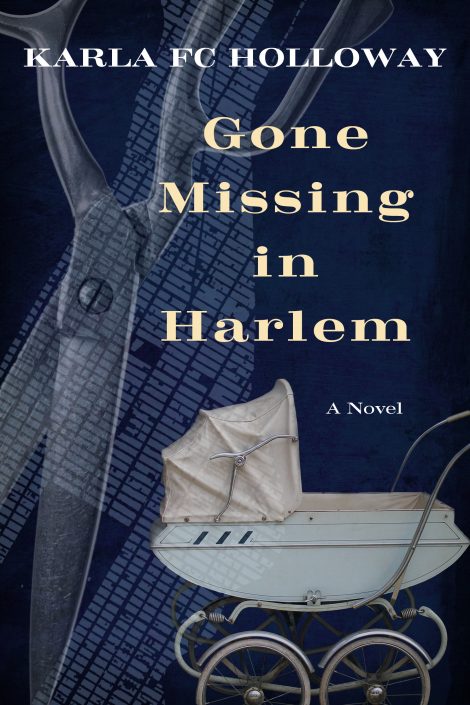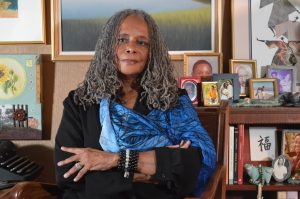
GONE MISSING IN HARLEM
A Novel
In her anticipated second novel, Karla Holloway evokes the resilience of a family whose journey traces the river of America’s early twentieth century. The Mosby family, like other thousands, migrate from the loblolly-scented Carolinas north to the Harlem of their aspirations—with its promise of freedom and opportunities, sunlit boulevards, and elegant societies.
The family arrives as Harlem staggers under the flu pandemic that follows the First World War. DeLilah Mosby and her daughter, Selma, meet difficulties with backbone and resolve to make a home for themselves in the city, and Selma has a baby, Chloe. As the Great Depression creeps across the world at the close of the twenties,
In her anticipated second novel, Karla Holloway evokes the resilience of a family whose journey traces the river of America’s early twentieth century. The Mosby family, like other thousands, migrate from the loblolly-scented Carolinas north to the Harlem of their aspirations—with its promise of freedom and opportunities, sunlit boulevards, and elegant societies.
The family arrives as Harlem staggers under the flu pandemic that follows the First World War. DeLilah Mosby and her daughter, Selma, meet difficulties with backbone and resolve to make a home for themselves in the city, and Selma has a baby, Chloe. As the Great Depression creeps across the world at the close of the twenties, however, the farsighted see hard times coming.
The panic of the early thirties is embodied in the kidnapping and murder of the infant son of the nation’s dashing young aviator, Charles Lindbergh. A transfixed public follows the manhunt in the press and on the radio. Then Chloe goes missing—but her disappearance does not draw the same attention. Wry and perceptive Weldon Haynie Thomas, the city’s first “colored” policeman, takes the case.
The urgent investigation tests Thomas’s abilities to draw out the secrets Harlem harbors, untangling the color-coded connections and relationships that keep company with greed, ghosts, and grief. With nuanced characters, lush historical detail, and a lyrical voice, Gone Missing in Harlem affirms the restoring powers of home and family.
- TriQuarterly Books
- Paperback
- April 2021
- 224 Pages
- 9780810143531
About Karla FC Holloway
 Karla FC Holloway is the James. B. Duke Professor Emerita of English and Law at Duke University, where her research and teaching have included African American literary and cultural studies, bioethics, gender, and law. She is the author of A Death in Harlem: A Novel, published by TriQuarterly Books.
Karla FC Holloway is the James. B. Duke Professor Emerita of English and Law at Duke University, where her research and teaching have included African American literary and cultural studies, bioethics, gender, and law. She is the author of A Death in Harlem: A Novel, published by TriQuarterly Books.
Praise
“This works both as a page-turner and a portrait of a vanished era.” —Starred review, Publishers Weekly
“…a spellbinding story about family, grief, and perseverance, full of rich and resilient characters you’ll fall in love with.” —Arianna Rebolini, BuzzFeed News
“With an evocative mix of questions and revelations, Gone Missing in Harlem shows a vivid sense of the lost and found. Karla FC Holloway again gives us the rich layers of Weldon Thomas’s detective work. Migration, abduction, and striving create the sense of wonder that fuels this resonant novel.” —Ravi Howard, author of Driving the King: A Novel
“The novel is both page-turning and deeply insightful into character, class, racism, ‘dreams deferred,’ and motherly love. At once a literary story of a family and a missing-person mystery, this genre-blending spotlights the different kinds of justice offered to African-American families, the trade-offs and sorrows of the Great Migration, and the compromised decisions a mother like DeLilah must make in order to save her family. The book’s historical detail and texture is exquisitely rendered and especially effective when used to demonstrate the great care that the women of Harlem use to protect their families in the small but important ways that they could. A compelling read, the novel is a significant contribution to the dynamic stories of the Great Migration and the Harlem Renaissance.” —Belle Boggs, author of The Gulf
“Gone Missing in Harlem is a lyrical stroll through Harlem’s heyday. From its dive bars and delicatessens to its high-toned parlors and kitchenettes, Karla FC Holloway’s sophomore novel brings the storied neighborhood to marvelous life. In the ‘dusk-dark,’ back-alley deals are made and undone as grieving women conjure ghosts of those gone missing, whether claimed by influenza, violence, or treachery. A thrilling, satisfying follow-up to A Death in Harlem.” —Cherene Sherrard-Johnson, author of Dorothy West’s Paradise: A Biography of Class and Color
“Karla FC Holloway’s incandescent characters and lyrical imagery inhabit a mystery story that probes one of life’s greatest puzzles—the secrets of the human heart. From the time-locked deep south to the vibrant streets of Harlem, Holloway’s intimate portrayal of African American life during the Great Depression transports readers to a time and place that may be all too recognizable for some, and unknown and hidden to others. Gone Missing in Harlem is brilliant: unforgettable, troubling, surprising, and, ultimately, completely satisfying.” —Manuel Ramos, author of Angels in the Wind
Discussion Questions
1. The book takes place in two distinct settings: Sedalia and Harlem. How does Holloway establish distinctions between the country and the city: the landscape, social life, and the promise they hold for DeLilah, her family, and all those who migrated north?
2. Holloway recounts the devastating effects of the influenza pandemic of 1918 through Iredell’s illness, and allusions to the terrible toll the illness exacted on Harlem’s working class Black community. How does this context resonate with the time of Covid-19?
3. Much of chapter seventeen is dedicated to a portrait of Harlem’s women. Revisiting this chapter, how does it offer a frame to understand DeLilah’s decisions to help ensure her family’s survival?
4. How does Holloway describe the various race and class-based distinctions in the lives of the women of Harlem and Hamilton Heights?
5. How would you characterize Officer Weldon’s style of policing?
6. In numerous places in the book, a character enters an internal reverie, usually distinguished by the author through italicized text. Compare one of Lilah’s reveries with those of another character—for example Enid Thayer, on losing her son, Edward. (157)
7. What is the relationship between Iredell’s memory and the particular qualities of light in which he appears to Lilah?
8. In chapter twenty-two the tone of the book shifts. How does Holloway use genre, and the gradual placement of revelations about Chloe’s disappearance throughout the book, to catalyze this discussion between Officer Weldon and LT?
9. While the Lindbergh connection in the story may not have turned out to be as it first seemed, the contrasts between the local police’s response to Chloe’s kidnapping and the federal response to the Lindbergh baby kidnapping feel truthful. What parallels can be found between the conversations had in the wake of the incident at Chasen’s and contemporary conversations about injustice in America?
10. In chapter twenty-four we see Weldon and LT attempting to work through the fine details of the case. Follow the course of their dialogue. How does Weldon guide and mentor his cadet, and how does LT help to inspire new thoughts in Weldon?
11. Speaking to Doris, Lilah describes Nella as having a precious quality of “loving kindness.” What are the moments in the book where we see this quality on display, and how does Holloway present them?
Interviews
Read “Gone Missing: PW Talks with Karla FC Holloway” at Publishers Weekly!
